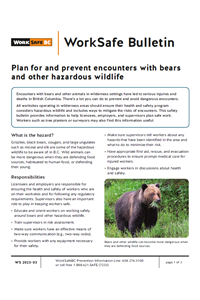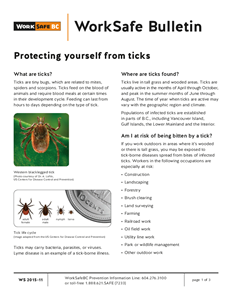Wildlife & insects
Encounters with larger wildlife like bears and cougars can result in serious injuries or even death, but working outside also carries risks associated with common insects and arachnids. The risks include bites themselves as well as resulting potential infections, which can still cause considerable harm or discomfort.
Employers are responsible for knowing the wildlife and insect risks present at the workplace and taking the steps to manage those risks to protect workers from injury and illness. Select a type below to see resources for working safely around different types of wildlife and insects.
Biting and stinging insects and arachnids — including mosquitoes, flies, spiders, ticks, bees, wasps, and hornets — can be found in every outdoor work environment. Anyone who works outdoors can be at risk from exposure to biting and stinging insects.
What is the hazard?
Most stings and bites are only minor injuries, with temporary pain, redness, swelling, and/or itchiness. However, some stings and bites can result in more serious health problems, including:
- Allergic or toxic reactions, serum sickness, or anaphylaxis
- Diseases such as West Nile virus from mosquitoes carrying the disease, Lyme disease from ticks, or other bacterial or viral infections
- Infection, especially if the bite or sting is scratched
How can I prevent insect stings and bites?
- Pay attention to areas where biting and stinging insects may be present, such as fields, gardens, woods, orchards, standing water, or near garbage containers or old buildings.
- Watch for webs and spiders when manually handling or moving items such as wood or rock piles, particularly if they have been undisturbed for a while.
- Avoid using scented products — including soaps, deodorants, lotions, hair products, aftershave, and perfume — since they can attract stinging insects.
- Wear clothing and footwear that fully covers your body, and keep it tucked in if possible. Choose clothing that is a single, neutral colour.
- Avoid sudden or rapid movements around insects as this could provoke them to sting.
- Use insect repellent containing 20 to 30 percent DEET. Zone repellents can also be effective for work in a defined area.
- Avoid letting food waste accumulate.
What should I do if I am exposed?
- Since you may not feel a bite or sting, after being in insect-prone areas check your skin closely, especially under the arms, behind the ears, between the legs, behind the knees, and in your hair.
- Check with the first aid attendant if you’ve been bitten or stung. Do this even for minor bites and stings as they could become more serious.
- If you are allergic to bee or wasp stings, carry the appropriate medication.
- Avoid scratching the sting or bite as this can cause infection.
- Monitor yourself for adverse signs and symptoms, and seek medical attention if signs or symptoms worsen.
Where are European fire ants found?
European fire ants are commonly found in moist, shaded places such as lawns, grassy areas, under decaying logs, and in yard waste and potted plants.
Who is at risk?
Anyone who disturbs fire ant nests is at risk of being stung.
What is the hazard?
The European fire ant has a stinger that can inject venom under the skin. After a sting, a burning sensation develops that can last from between 30 minutes and two hours. Burning is followed by itchiness that can last up to one week. At a minimum, stings cause swelling, redness, and discomfort. In rare cases, stings can result in a severe allergic reaction.
How can I prevent fire ant encounters?
To help prevent stings, wear clothing and footwear that cover exposed skin. For example, wear long-sleeved shirts, long pants, socks, closed-toe shoes (or rubber boots), and gloves. Pants can be tied or taped to socks or boots.
Where are bed bugs found?
Bed bugs can be found wherever people live, especially where they sleep. Bed bugs like to hide in dark places such as mattress seams, bed frames, upholstered furniture, and small building openings (such as electrical outlets).
Although bed bugs cannot fly or jump, they can climb onto items such as bags and clothing. This allows them to travel long distances. Bed bugs are rarely transferred directly from person to person. However, they can be transferred easily when someone comes in contact with infested items such as bedding.
Who is at risk?
You are more likely to be exposed to bed bugs if you work in one of the following industries:
- Health care
- Social services
- Building or property management
- Maintenance or cleaning
- Emergency services
- Communal or work-provided housing
What is the hazard?
There's no evidence bed bugs carry or transmit blood-borne diseases. Bites are normally painless. However, you may develop red, itchy spots on some parts of your body, such as around your face, neck, upper body, arms, and hands. Some people react within minutes, while others may have bite marks that appear after a few days.
How can I prevent bed bug encounters?
- Wear light-coloured clothing so you can easily spot bed bugs. Avoid pants with cuffs.
- For heavy infestations, wear disposable coveralls, gloves, and shoe covers. Tape down gloves and pant legs.
- Limit the number of items you bring into an area that may be infested.
- Hang bags and coats to keep them off the floor, or keep your belongings in a plastic bag or container.
- Change out of work clothes after visiting an area that may be infested. Place clothes in sealed plastic bags. Wash the clothes in hot water and dry them on the hottest setting. Put non-washable and dry-clean-only items in a hot dryer for 30 minutes or more.
Where are bears?
Bears can be found outside any city in British Columbia. Black bears can be found throughout the province. Grizzly bears can be found everywhere except Vancouver Island and Haida Gwaii.
Who is at risk?
Anyone who works in the outdoors, beyond city limits, is at risk. This can include workers in industries such as:
- Agriculture
- Construction
- Fishing
- Forestry
- Oil & gas
What is the hazard?
Animal attacks are extremely rare, but usually result in serious injury or even death when they happen.
How can I prevent bear encounters?
- Work in groups — bears are unlikely to attack a group.
- Keep your camp and work areas clean. Keep food away from sleep and work areas and pack all food and garbage in scent-proof canisters.
- Allow the animal to pick up your scent by keeping the wind at your back. Use extreme caution in strong wind or around loud water. Make noise to alert bears of your presence.
- Watch for signs that an animal is in the area. Leave the area if you see droppings, tracks, scratched trees, or food caches.
- Never approach bear cubs.
Where are cougars found?
Cougars are mostly found in the southern third of B.C. They are most active at dawn and dusk but can be found hunting any time of day or night in all seasons.
Who is at risk?
Anyone who works in the outdoors, beyond city limits, is at risk. This can include workers in industries such as:
- Agriculture
- Construction
- Fishing
- Forestry
- Oil & gas
What is the hazard?
Animal attacks are extremely rare, but usually result in serious injury or even death when they happen.
How can I prevent bear and cougar encounters?
- Work in groups — cougars are unlikely to attack a group.
- Keep your camp and work areas clean. Keep food away from sleep and work areas and pack all food and garbage in scent-proof canisters.
- Allow the animal to pick up your scent by keeping the wind at your back. Use extreme caution in strong wind or around loud water. Make noise to alert cougars of your presence.
- Watch for signs that an animal is in the area. Leave the area if you see droppings, tracks, scratched trees, or food caches.
- Never approach cougar kittens.
Highlights
- New resource outlines how to protect workers from encounters with hazardous wildlife Published on: July 21, 2023


